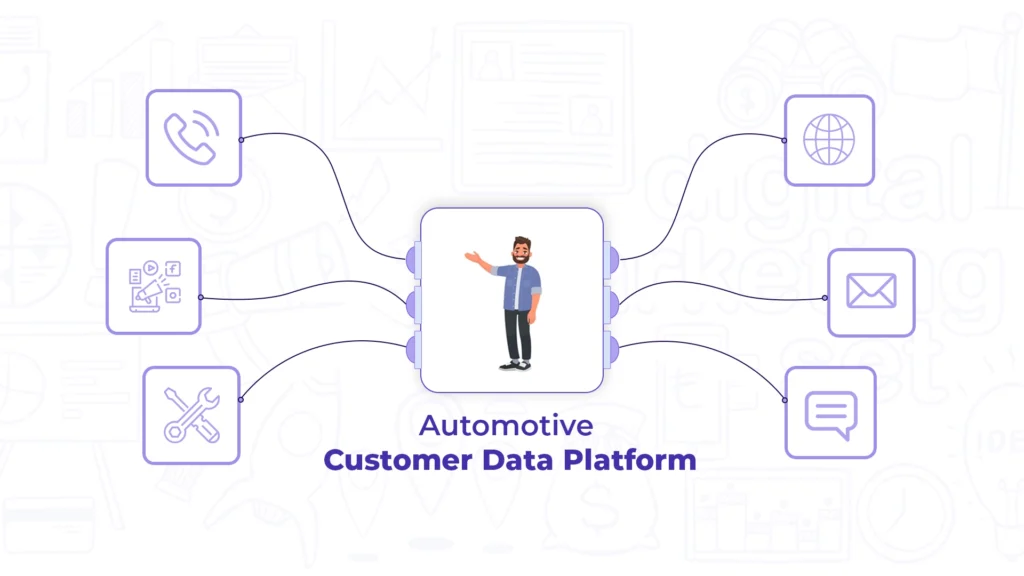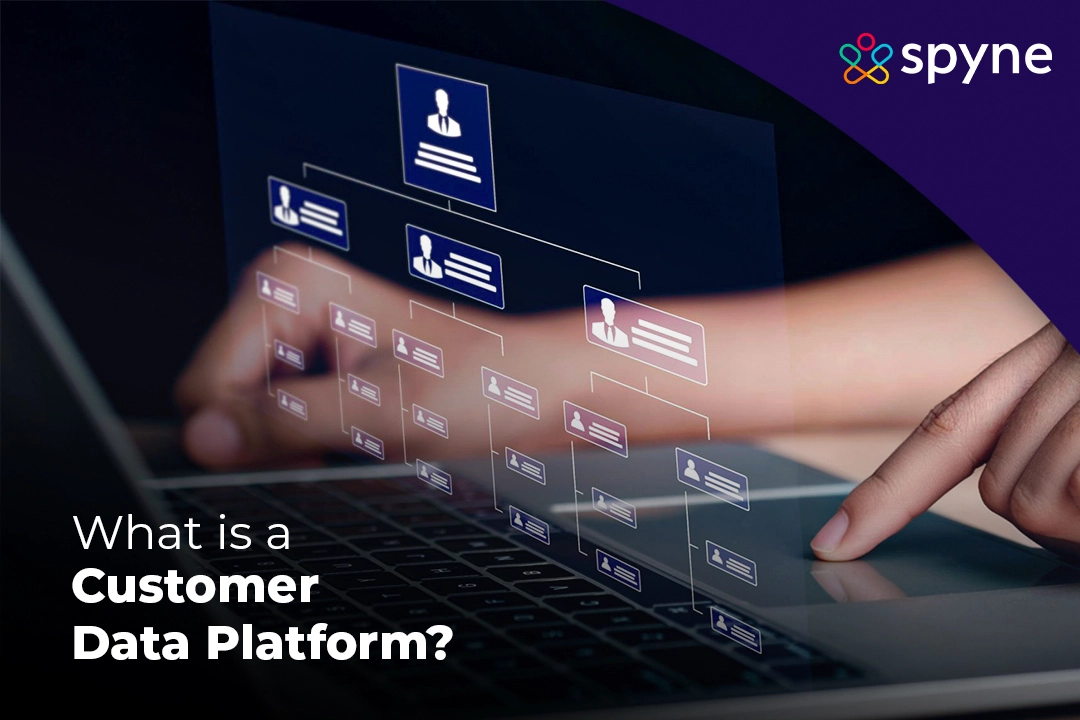In a world where every click, purchase, and interaction tells a story, businesses sit on a goldmine of customer data. It’s not, however, what you have; it’s what you do with it that really matters. For industries such as automotive dealerships, where customers have multiple interactions and touchpoints, this data can play a huge role in helping take strategic actions. That is where Automotive CDPs (Customer Data Platforms) come into play.
Although the term CDP might sound new, it has been around since the early 2000s. Back then, it was difficult to track customer data points due to scattered information. However, ever since 2016, CDPs really began to gain recognition – helping businesses improve their marketing strategy, product research, and whatnot.
Rather than just storing data, customer data platforms unify data, analyze it, and transform it into actionable insights to foster more innovative marketing, better customer experiences, and stronger loyalty. Used car dealerships can leverage this technology today to not only manage their customers but also understand how, when, and where their potential customers will look for them.
But before we dive into the details, let’s understand what Automotive CDP is.
What is an Automotive CDP?
An Automotive CDP (customer data platform) is a technology that uses multiple tools to collect and combine customer databases from any channel, system, or data stream and builds a unified customer profile. It also combines a database containing all the customer touchpoints and interactions with your product or service. That database can be segmented in real time for companies and allows them to create personalized marketing campaigns. Car dealership CDPs are very useful as a central database for user-level data, especially for used car dealerships.

The CDP’s goal is to provide a unified overview of customers to help dealerships improve their marketing, sales, and customer service efforts – making it essential for automotive dealerships – as it allows dealers to understand their customers better, personalize their marketing accordingly, and improve the overall customer experience.
CDP tools include a customer database, automation, and management resources for multichannel campaigns, real-time customer interactions, and connected data. They tie together databases that don’t share data traditionally, such as marketing platforms, e-commerce engines, and service software. This gives companies easy access to insights they need to connect with their customers. For instance, automotive CDPs provide easy access to customer’s data that helps auto dealers connect with their consumers and shoppers.
Understanding What a Customer Data Platform Does
A customer data platform creates a combined database of customer information that is accessible to all the other systems. A CDP provides an overview of each customer and each of their interactions and behaviors by combining customer data from multiple sources into a single platform. The data includes a lot of customer touchpoints such as online interactions, purchases, customer service inquiries, and social media activity. The data is updated in real time to make sure each customer’s latest interaction is recorded.
With a CDP, dealerships can get a better understanding of their customers and their interest in specific products and services they offer, so they can make better marketing, inventory, and pricing decisions. CDPs work hard to bring all the customer data into one place, combining the CRM in SaaS, DMS, inventory, website analytics, and ad data, then sorting and maintaining the data to create a singular profile of the shoppers and customers.
Dealerships can use the tools offered by CDP to break up the database, learn about customer behavior, understand their interests and their engagement with inventory, and create marketing campaigns accordingly. A dealership can determine which customers have expressed interest in their product within the past month. Then, they can target them with a special offer to close a deal. They can use the same data to target new potential customers with similar demographics, needs, and interests.
One can say that CDP offers dealers a flawless entry into the world of possibilities that exists with clean, unified, and actionable data. Automotive dealerships can utilize automotive CDP that can increase satisfaction and build customer loyalty that creates long-term repeat business, whether at the dealership itself, on the website, or through personalized marketing. The software is built to enhance the automotive customer experience.
CDP vs. DMP: What’s the difference?
DMP (Data Management Platform) is another system like CDP (Customer Data Platform) that handles customer data. While DMPs are designed for anonymous data and are used mostly for targeted advertising, CDPs focus on known customers.
Initially, DMPs were made to support marketers with digital advertising by using anonymous web cookies and device IDs. However, with increasing privacy regulations and the decline of third-party cookies, DMPs have faced limitations because of their focus on short-term and third-party data.
Whereas, CDPs were made to provide a detailed and continuous view of the customer. They include a lot of data, including first-party information from websites and apps. The database is then used to create focused marketing campaigns, improve customer service, and support data-driven decisions.
| DMP (Data Management Platform) | CDP (Customer Data Platform) | |
| Purpose | Handles anonymous data like cookies and device IDs | Handles detailed data about real customers, like their activities and preferences |
| Primary Use | It helps with showing online ads to the right people | It helps create a complete picture of customers for better marketing |
| Source of Data | Uses short-term data from outside sources | It uses long-term data collected directly from your website and apps |
| Data Type | Works best with third-party cookies, which are becoming less useful | Works well with modern privacy rules and direct customer data |
| How it’s used | Mostly for online advertising | Used for personalized marketing, customer service, and decision-making |
| Key benefit | Target ads based on general audience traits | It helps build stronger connections with individual customers |
CDP vs CRM: What’s the Difference?
Customer Relationship Management (CRM) primarily handles structured data like contact information and sales records, while CDPs can handle both structured and unstructured data, such as web browsing history or social media activity. This makes CDPs more versatile in their data handling.
CRM automotive software holds a record of all the new and old leads of a dealership. It is where the sales team works to approach leads, and it serves as an activity log for the BDC and sales teams so they know when to reach out to leads. However, the CRM gets loaded with junk, i.e. duplicate and cold leads, over time. This is where CDP comes in. The CDP takes duplicate leads and cleans them so there is a singular picture of every opportunity in the CRM.
The CDP will make sure that the same person isn’t being engaged in multiple different ways because their records are not consolidated. It will set the dealership up for marketing success as the data is stored in an actionable way, which allows it to be used for smart marketing campaigns, whereas dealership CRM data is not structured for this type of engagement.
| CRM (Customer Relationship Management) | CDP (Customer Data Platform) | |
| Type of Data | Handles organized data like contact details and sales records | Handles organized data like contact details and sales records |
| Main Use | Tracks lead, manages relationships, and records sales activities | Cleans and combines data to create a single view of each customer |
| Flexibility | Works with limited, organized data; often has duplicate or outdated information | Works with all kinds of data and ensures it’s accurate and useful |
| How it’s used in Car dealerships | Helps sales teams and staff track and contact leads | Improves CRM data and helps create better marketing campaigns |
| How Data is stored | Data is stored but not easy to use for marketing | Data is organized for easy and effective marketing |
| Key Benefit | Keeps track of lead interactions and sales efforts | Makes customer data clean and ready for better engagement |
The Role of CDPs in Car Dealerships
In the competitive landscape of used car dealerships, data platforms are not just an asset but a lifeline. Automotive CDP equips dealerships to unlock their full potential as customer data, when turned into meaningful insights, can help deliver measurable results. Whether it’s streamlining marketing efforts, enhancing customer retention, or operational efficiency, a CDP acts as the central nervous system for customer-centric strategies.
Here are a few key benefits that can help your used car dealership not only improve online presence but also attract relevant leads:
Personalized Marketing Campaigns
With an automotive CDP, you can now develop targeted marketing campaigns that would target specific customers who are interested in specific makes and models based on their interests, behaviors, and stages in the ownership life cycle. For instance, if a customer has shown interest in a certain make or model, you could send them ads or promotions targeted at that vehicle. This will not only increase the chances of sale but will also improve your potential customer’s experience by providing them with relevant information.
Improved Ad Effectiveness
You can target the right customer at the right time with the help of assurance for clean data in targeting audience segments on a wide range of marketing channels. A combination of clean customer data sourced from an automotive CDP and a powerful marketing technology platform will provide results like improved costs per conversion, reduced ad waste, and deliverability rates of up to 95%.

Organized Customer Data
An automotive CDP makes data ingestion easy by bringing all the sources of your data into one secure data lake. You no longer have to untangle data feeds to find or use the data you need.
From here, your customer information is an audience treasure trove you can customize based on strategy. You can easily create customer segments and target them with any outbound marketing channel to increase profitability on the sales and service sides. With these audiences at your fingertips, you can reach customers throughout their purchase or ownership journey.
Improved Customer Retention
CDPs help dealerships track key dates like service dues, expired warranties, and lease expirations, which help them maintain long-term relationships with their customers. Dealerships can proactively reach out to potential customers for reminder purposes, exclusive offers, or loyalty rewards to ensure customer retention and encourage future purchases.
Real-time Data Integration
Automotive CDPs offer real-time data processing, which means dealerships can respond to customer actions instantly. For instance, if a customer browses a specific car model online, the sales team can be alerted to follow up with tailored communication or offers, increasing the chances of closing a deal.
Better ROI Measurement
Centralizing customer data and integrating it with other marketing tools gives dealerships a clear picture of the ROI on their marketing. You can track which campaigns worked, understand customer behaviors across channels, and adjust your strategies for maximum efficiency.
In short, an automotive CDP is not only a data management tool but also a strategic asset that can revolutionize how you understand, engage, and retain your customers in an increasingly competitive market.
What Should Automotive Dealers Look For In A CDP?
Choosing the right CDP is vital for automotive dealerships looking to increase customer engagement and make things more efficient. Here are the most important things to consider in choosing a CDP:
1. Data Cleansing and Accuracy
Keeping the data clean and accurate is an important component in marketing and CRM. Some CDPs have automated data cleaning services that cleanse your database regularly, free of charge.
2. Data Security and Compliance
The CDP must offer robust security, such as data encryption, to protect the information of your customers and prevent possible fines for violations of privacy regulations.
3. Full Data Integration
The CDP must be able to fetch data from all relevant sources: your website, CRM, DMS, social media, and advertising channels. This ensures full integration to deliver a unified view of your customer, thereby enhancing the success of your marketing strategy.
4. Real-Time Data Processing
Real-time data processing will enable your dealership to respond in real-time to customer interactions, thereby enhancing engagement and the chances of conversion.
5. Scalability and Flexibility
Make sure it is a CDP that grows with your dealership and adapts to the change of business needs over time, which would have long-term viability and return on investment.
6. User-Friendly Interface
A CDP should have an intuitive interface so that your team can efficiently use its features without extensive training, promoting productivity and user adoption.
7. Vendor Support and Reputation
Consider the reputation in that industry by evaluating the quality of their customer-support services. Satisfactory and reliable support becomes invaluable to a dealer while combating challenges or while maximizing CDP benefits.
Hence, choosing a suitable CDP requires considering most of the critical factors mentioned above. These aspects evaluate the system required by dealers with respect to growth and other forthcoming technological development areas.
Why Should Businesses, Particularly Automotive Dealerships, Care about CDPs?
The automotive industry has been known for the constant change of numbers in data. The customer information is scattered across various systems. The complexity of this sector, accompanied by the wide network of automotive CRM and DMS platforms, services and parts systems, third-party lead providers, and marketing platforms, creates a large pool of data sets. This dispersion of information prevents a single perspective of the consumer and reduces the effectiveness of marketing and customer service strategies.
Every point of interaction, whether for sales or service, is managed by different vendors, each managing its own subset of customer data. For example, a customer’s purchase history might be in DMS, while their website browsing behavior is in a separate marketing platform. This is a major challenge for dealerships that want to collect and analyze their customer data. This scenario leads to missed sales opportunities. That’s why, overcoming databases and unifying scattered data sources have become a topmost priority for dealerships. This is where CDP comes in to save the day and make their job easier by collecting and combining the databases in one place.
The Value of a Customer Data Platform
A CDP helps businesses grow in the competitive market, build strong relationships with their customers, and stay profitable. To stay ahead in the industry, it is important to understand CDP fully and use it to its full potential. Here’s the value a CDP holds:
1) Combined Customer Perspective: CDPs collect data from various sources and provide a 360-degree view of a customer’s interaction with the business. The journey provides a look into a customer’s behavior and needs.
2) Improved Personalization: Businesses can create personalized marketing campaigns, strategies, and messages, to make customer experiences better, which will lead to an increase in customer loyalty.
3) Data-Based Decision-Making: Detailed customer data helps make a way for data-driven decision-making which improves marketing tactics and strategies and improves operational efficiency.
4) Promote Data Security and Compliance: CDPs help businesses with data protection regulations and make sure the collected data from different sources is secure.
Benefits of Implementing a CDP at Your Car Dealership
A CDP can offer several major plus points that can help your dealership get a leg up in this ever-evolving auto market. It can transform the way your dealership interacts with your customers which will result in more effective marketing. The following are the benefits of implementing an automotive CDP:
1) Removing Data Silos
CDPs gather up the siloed first-party data sources and create a singular and clear picture of all the ongoings in your dealership. It builds a single source for all the analytics and information about the dealership as well as your customers.
2) Creating a 360° View
CDPs will track every customer’s touchpoints and interactions with your dealership, from their first ad or website click to a vehicle purchase, to their next service appointment. It will do so by bringing together the website data, automotive CRM, and advertising data.
3) Providing Personalized Experiences
CDPs will create 360° profiles that will help you personalize your approach at every interaction on the customer journey based on the customer’s needs and interests.
4) Improving Your Marketing Efforts
Automotive CDP will clean and normalize the databases using identity resolution technology that will remove leads and create a singular shopper profile so your dealership can stop marketing to the same lead twice.
5) Improve Customer Experience
CDp will help capture customers’ journeys and capture their lifetime value (LTV) by using data to gain a view into your operations and improve the customer experience at your dealership.
6) Ensuring Data Security
It is important that your dealership is fully compliant with the FTC safeguard rules. CDPs use top-level encrypted technology to keep your data safe.
Core Components of an Automotive CDP
You might have noticed that many CDP providers offer similar services on various levels. It is important to understand each feature and learn more about the capabilities that are included to understand whether or not the platform will meet your automotive dealership’s needs. The following are the core components an automotive CDP must have:
1) Data Integrations
Your CDP should be able to connect with multiple dealership-specific data sources because a good CDP gathers data from all the sources, including your CRM, DMS, websites, social media, and more to analyze customer data and create a detailed view of your customers’ profiles and their interactions with your dealership.
2) 360° Profile Views
Combining scattered customer data to create a singular and clear customer profile from various data channels is an important and core function of a CDP. When done properly, 360° profiles will allow you to track every customer engagement with your dealership in one orderly profile. This includes website visits, ad clicks, email interactions, visits or calls, appointments and more.
3) Data Insights & Analytics
Your CDP should provide analytical tools for examining customer behavior, trends, and patterns to predict future customer actions. This is an important feature. This can make your dealership smarter, able to make educated inventory decisions and construct marketing strategies that will meet expected customer needs.
4) Real-Time Data Processing
Your CDP should have the capability to handle and process real-time data and make changes to every profile as it happens. Humans are not capable of syncing real-time data from multiple sources. With the help of a CDP, you can make sure your dealership is always keeping accurate customer information.
5) Resolving Multiple Identities
Combining data from multiple sources can create duplicate profiles for the same person. Therefore, CDP will identify and resolve customer identities across various platforms and combine them into one profile. It is not a feature to sleep on as this will make sure your dealership is working with accurate and up-to-date information.
6) Sectioning Audiences
Your CDP should be able to build targeted lists or audiences based on specific demographic or shopper criteria pulled from all the scattered data. This component allows you to create a new level of personalization that meets the shopper’s needs directly, making sure you provide value at every interaction and touchpoint.
7) Data Privacy and Security
Poor data security increases your chances of leaks and lawsuits. But you can avoid that by investing in a good CDP. Your CDP should have robust data management and governance features to make sure that your customer data is accurate, updated, and secure.
8) Customization Options
Personalization is an important component of success when it comes to the modern world of retail as it helps increase retention by creating one-on-one experiences for your customers. CDP can contribute by creating shopper profiles so you can use that data to create personalized and targeted experiences.
Challenges of Implementing a CDP in a Car Dealership
Implementing an automotive CDP in a car dealership presents challenges, though it shouldn’t be overwhelmingly difficult. Furthermore, the following are some common challenges car dealerships face when implementing a CDP initially:
1) Complex Data Combining Process
Collecting and combining data from different sources of your dealership can be tough and can take time. This can be avoided by performing proper research and making sure that your platform is compatible with the data providers.
2) Training Employees
New tech can be scary for the team. Lack of understanding or resistance towards change can cause difficulties in adopting the technology and realizing its potential. It is important that the team is offered training opportunities to learn how to use this new technology.
3) Challenges in Customization
Every dealership has its unique process and way of doing things. Designing the CDP to align with the needs of your dealership may require customization which can be challenging and can extend the implementation timeline. Your vendor should know how much time it will take so you can prepare beforehand.
CDP Cost & Pricing Considerations
Investing in a CDP is a long-term commitment that turns out to be savings for your dealership. It is important to carefully check the costs and pricing options to make proper decisions that will suit your budget and goals. Here are a few points to keep in consideration:

1) One-Time Costs vs. Subscription Fees
Some CDPs offer one-time licensing fees, while some offer subscription-based pricing. First, consider which option fits the best with your dealership’s needs and budget. It is very important to know that subscription models grant access to new features when they are released, which means your software will get better over time.
2) Customization and Implementation Costs
Some CDPs provide customization and implementation packages that help dealerships get up and running quickly. These packages may come with additional costs sometimes, so make sure you factor them into your business budget.
3) Maintenance and Support Costs
Make sure you carefully consider and calculate the costs of maintaining and supporting your CDP needs. Look for a software provider that will offer flexible and all-inclusive support options.
Also, do make sure you’re completely aware of the costs, the payment schedules, and the contract timeline you’re signing up for. This will make sure that you have chosen a CDP that fits your needs as well as your budget.
Automotive CDPs + AI: The Ultimate Tool to Empower Dealerships
Automotive dealerships can use their customer data in a friendly and accessible way by combining automotive CDP with AI. This union makes dealerships able to make data-driven decisions, create personalized experiences, and stay ahead in this competitive market. With this collaboration, dealerships can:
1) Use Real-Time Customer Data
AI-driven analysis with CDPs helps with delivering real-time data on customer behavior and preferences. This keeps your marketing equipped with up-to-date information for timely decision-making.
2) Create Smooth Journeys Across Platforms
Dealerships create flawless customer journeys both online and offline. Furthermore, by combining dealership data with AI’s analytical abilities, you can analyze your customers’ preferences and needs to make informed next steps.
3) Automate Marketing Campaigns
AI takes the work out of personalized marketing by automating the creation and optimizing the ad and email campaigns using real-time data from the CDP. This means that your campaigns are targeted and are being adjusted in real time based on the data and customer interactions.
4) Improve Inventory Management
AI analyzes real-time customer needs and preferences from the data gathered by CDP. It will help you with car inventory management. AI recommends specific vehicles and parts that customers might be interested in, increasing the chances of sales.
Conclusion
Clearly, customer data platforms (CDPs) are changing the game, no matter the industry. For auto dealers, automotive CDP helps them understand their customers better and offer a more personalized experience. As this industry moves forward, CDPs will be key in staying ahead and keeping the customers happy!
















